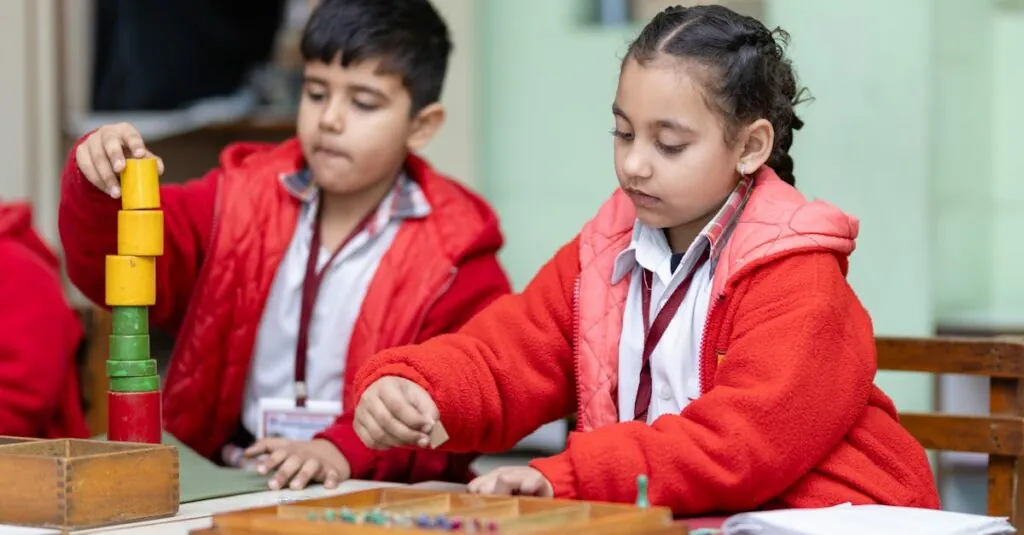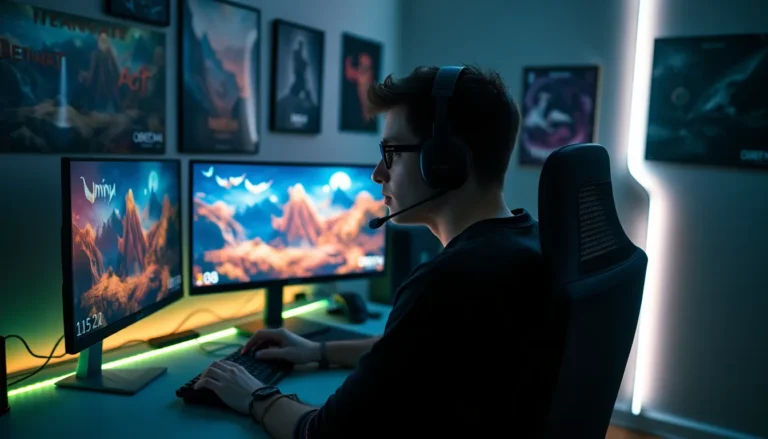Table of Contents
ToggleWhen it comes to child development, parallel play is like the unsung hero of the playground. Picture this: toddlers happily building their own block towers side by side, completely absorbed in their own worlds yet blissfully unaware of each other’s masterpieces. It’s not just cute; it’s a critical stage in social development that lays the groundwork for future friendships and teamwork.
Understanding Parallel Play
Parallel play serves a vital role in child development, promoting social skills through independent play near peers. During this phase, children engage in separate activities while observing each other, laying the groundwork for future interactions.
Definition of Parallel Play
Parallel play occurs when children play alongside one another but do not directly interact. This behavior typically manifests in toddlers aged 2 to 3 years. Through parallel play, children explore their environment, develop motor skills, and begin to understand social dynamics. Although they may not engage in cooperative activities, they benefit from watching their peers. Understanding this stage is crucial, as it represents a stepping stone toward more interactive play in later developmental phases.
Characteristics of Parallel Play
Several key characteristics define parallel play. Children frequently engage in similar activities, such as building with blocks or drawing, while maintaining their individual focus. They may occasionally glance at others’ creations, sparking interest without direct collaboration. Social awareness begins to blossom, as children start imitating actions or vocalizations from peers. Additionally, their ability to share the same space without conflict highlights emerging social skills. As this type of play unfolds, it fosters independence and self-confidence, vital components for future teamwork and friendships.
Stages of Child Development
Child development includes various stages, with parallel play being a pivotal phase. This moment fosters independence while laying a foundation for social interaction.
Role of Parallel Play in Early Development
Parallel play encourages toddlers to engage in activities that enhance their motor skills and cognitive processes. Children often imitate peers during this phase, helping them develop social awareness. They focus on their individual projects, such as building blocks or drawing, while still being aware of others nearby. This behavior builds confidence as children learn about their environment through independent exploration. Strong opportunities for creativity emerge during these interactions, allowing for individual expression and self-discovery.
Transition to Cooperative Play
Transitioning to cooperative play marks a significant milestone in social development. As children experience parallel play, they gradually begin interacting with peers in more meaningful ways. Opportunities for sharing, taking turns, and group activities come into focus as they develop communication skills. Social dynamics shift when children start forming friendships and working together. Engaging in joint projects further solidifies these connections. This evolution signifies a critical step towards developing teamwork abilities, underscoring the importance of earlier parallel play experiences.
Benefits of Parallel Play
Parallel play offers significant benefits for child development, particularly in social and cognitive realms. As children engage alongside one another, they prepare for future interactions.
Social Skills Development
Social skills flourish during parallel play. Children watch their peers, learn social cues and gain understanding of sharing and cooperation. They develop patience as they navigate their own activities while being aware of others. Imitation plays a key role; behaviors exhibited by peers often become models for emerging social interactions. As they glance at what others are doing, they begin to appreciate collaborative dynamics. Over time, this social awareness lays a strong foundation for meaningful friendships, which becomes evident as they transition to more interactive play.
Cognitive Skills Enhancement
Cognitive skills also see substantial enhancement during parallel play. Engaging in similar activities allows children to explore their creativity while investigating their environments. Focus shifts to individual tasks but remains influenced by nearby peers. Through this engagement, they hone problem-solving abilities as they tackle challenges presented by their projects. Observing peers can introduce new concepts and techniques, fostering critical thinking. As children construct their understanding of the world, these experiences contribute significantly to cognitive growth, setting the stage for future learning and development.
Factors Influencing Parallel Play
Parallel play in child development is influenced by multiple factors that shape how toddlers engage with their peers. Understanding these elements helps in recognizing the nuances of this stage.
Age and Developmental Milestones
Age plays a crucial role in parallel play. Typically, children aged 2 to 3 years exhibit this behavior as they reach significant developmental milestones. During this stage, toddlers gain motor skills, enabling them to manipulate toys and objects independently. Cognitive growth also occurs, allowing children to process their surroundings and observe others. As they approach the age of 3, children’s social awareness heightens, leading to increased imitation of peers. Developmental milestones at this age lay the groundwork for smoother transitions to more interactive types of play, reinforcing the importance of parallel play in early childhood.
Environmental Factors
The environment significantly influences the occurrence and quality of parallel play. Safe, stimulating spaces encourage toddlers to explore and interact with a variety of toys and peers. Accessible play areas, whether at home, daycare, or parks, enable children to engage in parallel play comfortably. The presence of peers also affects engagement levels. Toddlers tend to participate more when they see others involved in similar activities, motivating them to imitate and explore. Socioeconomic factors play a role, as well; rich sensory experiences and diverse social interactions foster more robust parallel play opportunities.
Parallel play stands as a fundamental aspect of child development that often goes unnoticed. It nurtures essential skills like independence and social awareness while laying the groundwork for future friendships. Through this stage, children not only enhance their motor skills but also learn to navigate social dynamics by observing and imitating their peers.
As children engage in parallel play, they cultivate creativity and problem-solving abilities. This independent exploration fosters confidence and self-discovery, which are vital for later cooperative interactions. Recognizing the significance of parallel play can help caregivers and educators create supportive environments that encourage this important phase, ultimately facilitating smoother transitions into more interactive play.








